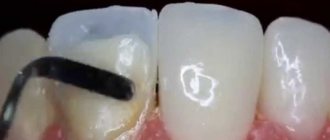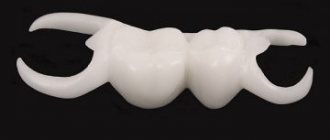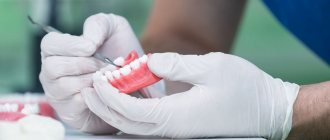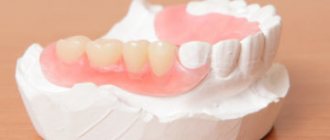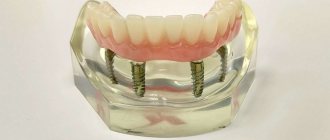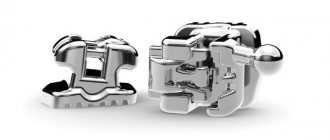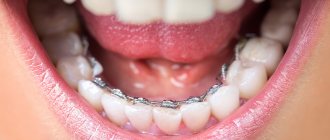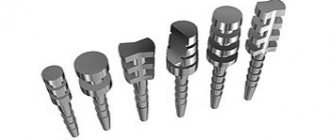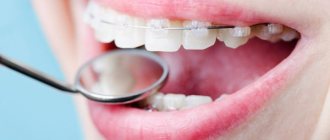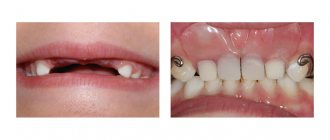What it is?
An immediate prosthesis is an orthopedic structure, which translated from English means “immediate prosthetics” or “immediate prosthetics.” What does it mean? Such a structure is often installed immediately after tooth extraction.
You may be interested in: Laser in dentistry: indications for use, contraindications, reviews
You are offered an immediate prosthesis. What it is? Essentially, a temporary removable orthodontic structure that the patient uses while his permanent prosthesis is being made. It is often used before dental implantation. The fact is that a titanium root rod can take up to several months to take root. During this period, a temporary denture replaces the missing tooth.
There are several reasons for turning to such prosthetics. As a rule, after the removal of a damaged or diseased tooth, its neighbors try to occupy the resulting empty space. A temporary denture will prevent row displacement, which can be accompanied by a whole list of complications. In addition, immediate dentures also take on part of the chewing function. This is important for the absorption of food and the complete digestion process. We must not forget about the aesthetic function. Especially in cases where a front tooth is removed.
You will be interested in: Is a tooth removed with gumboil: features of the situation
Immediate dentures - all about the painless method of removable dentures
A removable orthopedic structure, an immediate prosthesis, takes its name from the English word immediate. Translated into Russian it means “immediately.” This prosthesis often saves the situation immediately after tooth extraction. It is also credited with the name “butterfly” due to its special design features: it has the appearance of an artificial crown part of a tooth, equipped with special hooks on the sides, which makes it look like a butterfly or a bird (which is why some patients mistakenly call it a “bird” immediate prosthesis). .
The prosthesis has a soft base, the color of which matches the natural tissues of the mucosa. With the help of hooks - clasps, the prosthesis is fixed to the dental units located on the sides of the row defect. For a more durable fixation, a special glue used for removable dentures can be used.
Solving the problem of edentia, and in particular its aesthetic component, with the help of an immediate prosthesis is a quick, painless and fairly economical way to restore the integrity and former attractiveness of a smile, and self-confidence for the patient.
How is the prosthesis installed?
Immediate dentures are attached to the teeth using special hook clasps. The fulcrum here can be either natural teeth or implants. In some cases, special glue or cement is used for more reliable fixation.
In any case, installation of a prosthesis will be the most inexpensive, painless and quick. In most cases, it is chosen in case of loss of one or more teeth. It is important to note that, despite the comparative cost-effectiveness of this method of prosthetics, the patient receives an artificial tooth, which in appearance is practically indistinguishable from the real one.
Pros and cons of the butterfly prosthesis
Installing this design has undeniable advantages. For many patients, it remains important that neighboring teeth are not injured. The butterfly prosthesis does not require turning of adjacent incisors. When fitting a product, only the structure itself is processed.
The product is also distinguished by high aesthetic values. If you opt for a prosthesis that does not contain metal clasps in its design, it will not be easy for others to notice it.
The butterfly prosthesis is a budget option, so it is accessible to absolutely everyone, and the price has little effect on the length of wearing it. If the structure was installed only while the hole was healing, and then for some reason it was not possible to install a crown or implant an implant, this option for dentition reconstruction can be used as a permanent one.
Another positive point is ease of use. The patient can independently remove the structure, carry out the necessary hygiene measures, and then independently fix the system in place. I would also like to note that this design does not require the purchase of special care products. Using a toothbrush and toothpaste will suffice.
Having studied the reviews of patients at the dental clinic, we can say about the following disadvantages of the butterfly denture:
- It is not always possible to achieve high-quality fixation of the prosthesis using plastic clasps, and their manufacture using metal disrupts the aesthetic appearance;
- poor fixation of the structure can occur with certain characteristics of the bite or when the supporting teeth are small;
- also, many patients note the fragility of the structure, which leads to rapid wear of the prosthesis;
- prosthetic systems made of nylon require a special diet and avoidance of solid foods.
A butterfly denture can be installed at any age of the patient, but its use is still not recommended for adolescents. This is due to the still unfinished growth of the jaw arches. Therefore, this method of prosthetics is considered costly and impractical.
Indications for installation
Immediate dentures are indicated for both adolescents and adults. The main goal of this design is the functional and aesthetic restoration of the dentition. As we have already noted, the prosthesis fills the gaps between the teeth and prevents their displacement.
You may be interested in:Temporary filling material: description, characteristics and indications for use
The use of an immediate prosthesis will be justified in the following cases:
- The need for removable dentures for one or two adjacent teeth. In particular, it is used for installation in the chewing area.
- Removal of a damaged or diseased tooth before permanent prosthetics - implantation or transplantation. In case of tooth loss, immediate dentures can be prescribed before the installation of a bridge. In particular, this helps to get rid of aesthetic discomfort in case of removal of front teeth. Therefore, a temporary immediate prosthesis is often installed in the frontal area of the dentition.
When installing such a structure, not only chewing and aesthetic functions are ensured, but also the risk of atrophy of bone tissue under the prosthesis itself is reduced. They do not deform or decrease in volume.
Varieties
Let us dwell in more detail on the types of immediate prostheses. There are three types in total:
- Partial immediate prosthesis. This variation is established in cases where it is necessary to restore up to four teeth in one row. Compared to the same “butterflies”, this is a more cumbersome design. The supporting part for the convenience of fixing the partial denture is more voluminous. Similar designs are intended for installation in the chewing section. They help the entire dentition participate in chewing food.
- Immediate prosthesis “butterfly”. This is a removable design that allows you to replace one to three teeth. It is a nylon or acrylic immediate prosthesis. This name is given because the supporting parts of the structure resemble the wings of a butterfly. But if we consider the prosthesis as a whole, it is nothing like this insect. Similar options are prescribed in case of temporary replacement of teeth in the frontal and chewing areas. This design is popular among both patients and specialists because of its relatively low price and ease of manufacture.
- Complete immediate denture. This is a removable structure that is designed to model either the upper or lower jaw. Accordingly, it is used in cases of complete edentia - the absence of all teeth in a row. The main difference between this prosthesis and the ones described above is that this removable structure can be used on an ongoing basis. Can also be installed supported by implants.
Types of immediate prostheses
In dentistry, there are several types of immediate dentures. They are divided according to several criteria.
Based on the material used, they are divided into nylon and acrylic. The former are a soft, elastic structure that can be effectively used to restore up to three row units. The second group is more rigid prostheses, but also more durable.
Based on the type of fixing structure of immediate dentures, it is customary to distinguish 2 types of them: with metal and plastic fixing elements (the first are made in the form of peculiar hooks, the second are in the form of clasps). It is worth noting that in the first case, the metal will be quite clearly visible when you smile, but its advantages include the strength of its fixation. More often it is used for prosthetics of chewing teeth.
When fastened, plastic elements involve not only row units, but also, to a certain extent, soft tissues - there is an expansion at the base of the prosthesis, which also helps ensure the stability of the orthopedic structure. Such dentures are an excellent solution for filling row defects that are visible to others when you smile.1
How to make
What it is—an immediate prosthesis—is already clear. A removable orthodontic structure that can be installed immediately - immediately after the removal of damaged or diseased teeth. Modern immediate dentures look very natural and natural - their installation is almost invisible. Which is very important for patients who require prosthetics of the frontal part of the dentition.
Most of these designs are made of acrylic or nylon. Consequently, they have a soft base that imitates the gums and the palate. Today, the highest quality and most comfortable orthodontic structures are nylon. Such immediate dentures are in demand because they do not cause an allergic reaction and are the most natural in aesthetic terms.
These structures are manufactured in dental laboratories. The entire process of creating an individual immediate prosthesis requires specialists 1-2 weeks. As for structures for the frontal portion of the dentition (front teeth), this system is the most difficult to manufacture. This is why the time frame for its creation may be slightly longer than standard.
How to properly care for a butterfly prosthesis?
Butterfly dentures require the same regular care as natural teeth. They should be brushed with a soft toothbrush at least twice a day. Brushes with hard bristles cannot be used to clean dentures of this type - they can scratch the surface of the denture, and pathogenic bacteria will actively develop in these microcracks.
Once or twice a week, the butterfly should be placed in a specialized disinfectant solution. Recommendations on the choice of solution should be given by the attending physician. It is also recommended to remove the denture after each meal and rinse it thoroughly under running water. This will prevent food debris from accumulating on the structure, eliminating the development of gum inflammation, caries and the appearance of bad breath. At night, it is also advisable to remove the prosthesis and place it in the solution. This approach to operating the butterfly will ensure a long useful life.
Stages of manufacturing a structure
The main stages of manufacturing an immediate prosthesis are as follows:
- Taking an impression before tooth extraction. Moreover, not only he himself is taken into account, but also his neighbors, since they will be the support for the future prosthesis.
- Creating an exact copy of the tooth being removed.
- Placement of fasteners on the prosthesis in support of impressions of adjacent teeth.
- Trying on the manufactured structure. If necessary, its correction.
- Installation of immediate prosthesis.
In the case when microprosthetics is carried out not after extraction, but after tooth loss, a control model of the structure is created. After trying it on, the necessary corrections are made and the prosthesis itself is made.
The advantages of this prosthetics
Among the main advantages are the following:
Design flaws
Immediate dentures are popular because they are a comfortable temporary (and in certain cases permanent) replacement for lost teeth. They perform the chewing functions of the lost tooth and look aesthetically natural. But the orthodontic design also has its disadvantages.
The most annoying disadvantages are the fragility and fragility of the prosthesis. A number of patients also note the difficulty of getting used to such a design. In particular, discomfort in the mouth, problems with diction.
But with the development of orthodontics, these problems are gradually smoothed out and become less obvious. Immediate dentures are becoming more and more comfortable, durable and aesthetically natural.
Cost of prosthetics
It is difficult to name a universal price for immediate prosthetics. The cost of this design, first of all, depends on the number of teeth being replaced and the names of materials used to create the prosthesis.
So, if you order a “butterfly” for one tooth, it will cost you 2-4 thousand rubles (depending on the city and clinic, the cost may vary). If a partial or complete prosthesis is made, then its price can reach 30-40 thousand rubles.
It is possible to determine the exact cost of the structure in each individual case only after consultation with a specialist and a visual examination of the patient by the doctor.
Reviews
On the Internet you can find a wide variety of reviews about immediate prostheses. Basically, patients are attracted by the availability of this method of prosthetics. In most cases, the structure is quickly made the very next day after the impression is taken. An excellent alternative to implants in the case of front teeth.
But this method of prosthetics will not last forever. Structures often break, especially acrylic ones. If they fall, they most often break. Therefore, great attention must be paid to care and storage. Some reviewers noted that for a long time they could not get used to the prosthesis. While other patients felt discomfort only in the first days.
Immediate prosthetics are the fastest and most inexpensive today. Both temporary and permanent structures are installed. The most important thing is not to forget about caring for the prosthesis and handle it carefully.
Source
Advantages and disadvantages
The butterfly prosthesis has a number of significant advantages:
- absence of a preparatory stage in the form of turning adjacent teeth: when adjusting the structure, it is processed rather than the supporting dental units,
- absence of surgical intervention, violation of the integrity of the mucous membranes,
- aesthetics: restoring the integrity of a smile, even in this temporary way, for many patients is an opportunity to avoid self-doubt and psychological discomfort,
“I was recently fitted with an immediate prosthesis to replace an extracted tooth, I must note that the aesthetics are excellent - it is not conspicuous, in conversation and when smiling it is not at all noticeable to others. It didn’t take long to get used to it either; it didn’t interfere even at the stage of healing of the hole.”
Denis O., fragment of a message from a dental forum
- Efficiency of production: during the first visit, the doctor will make an impression, and installation is carried out at the next visit. More time will be needed only when manufacturing a structure with a cast frame,
- possibility of use as a temporary measure,
- ease of use: you can put on and remove the prosthesis yourself, it does not require special care,
- affordable price: a nylon immediate prosthesis for one tooth costs on average 5.5 thousand rubles, acrylic – 7-10 thousand rubles. If it is necessary to replace all defects, the cost can be about 25-40 thousand rubles.
However, it is worth paying attention to the disadvantages of this solution: the structures are fragile and short-lived when compared with other methods of prosthetics. In some cases, they cause difficulties in getting used to - temporary speech defects, some discomfort in the oral cavity. Also, they cannot be worn for more than the allotted period (from two weeks to six months in the case of dental implantation). Nominally, they can last longer - but the aesthetics of the smile, alas, will become worse, because materials such as acrylic and nylon tend to absorb odors and food coloring.
